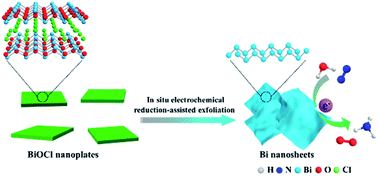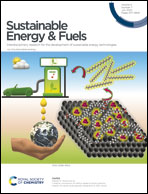In situ electrochemical reduction-assisted exfoliation: conversion of BiOCl nanoplates into Bi nanosheets enables efficient electrocatalytic nitrogen fixation†
Abstract
The electrocatalytic nitrogen reduction reaction (NRR) for ammonia (NH3) synthesis is highly desirable yet still challenging. Catalysts, as the core component of electrocatalytic NRR systems, are a specific focus of research. In this work, we demonstrate that NRR active semimetal bismuth (Bi) ultrathin nanosheets (Bi NSs) could be prepared by means of the in situ electrochemical reduction-assisted exfoliation of BiOCl nanoplates (BiOCl NPs). Such a conversion, from semiconductive BiOCl NPs to semimetal Bi NSs, could create enlarged surface areas and bring about abundant under-coordinated Bi sites and accelerated electron transport capability. With these advantageous properties, the as-converted Bi NSs exhibit efficient NRR electrocatalytic activity in 0.1 M Na2SO4, achieving a high faradaic efficiency (14.14%) and NH3 yield (11.11 μg h−1 mgcat.−1) at −0.5 V (vs. reversible hydrogen electrode), as well as high NH3 selectivity.



 Please wait while we load your content...
Please wait while we load your content...